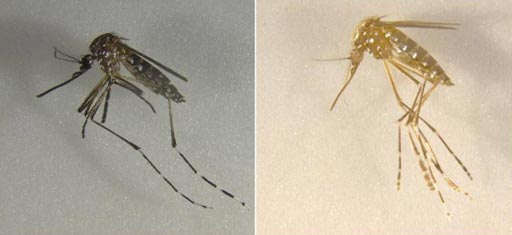Transgenic Cas9 Mosquitoes Used to Target Disease Carriers
By LabMedica International staff writers
Posted on 29 Nov 2017
Insertion of the gene encoding the Cas9 enzyme into the germline of Aedes aegypti mosquitos represents a step toward the development of novel population control technologies targeting this carrier of serious viral pathogens including dengue, chikungunya, yellow fever, and Zika.Posted on 29 Nov 2017
The development of CRISPR/Cas9 technologies has dramatically increased the accessibility and efficiency of genome editing in many organisms. In general, in vivo germline expression of Cas9 results in substantially higher activity than embryonic injection. However, no transgenic lines expressing Cas9 have been developed for the major mosquito disease vector Aedes aegypti.

Image: CRISPR/Cas9-mediated disruption of genes associated with cuticle pigment caused mosquitoes to turn from black to yellow, and disruption of genes associated with eye pigment caused eye color to change from black to white (Photo courtesy of the University of California, Riverside).
CRISPR/Cas9 is regarded as the cutting edge of molecular biology technology. CRISPRs (clustered regularly interspaced short palindromic repeats) are segments of prokaryotic DNA containing short repetitions of base sequences. Each repetition is followed by short segments of "spacer DNA" from previous exposures to a bacterial virus or plasmid. Since 2013, the CRISPR/Cas system has been used in research for gene editing (adding, disrupting, or changing the sequence of specific genes) and gene regulation. By delivering the Cas9 enzyme and appropriate guide RNAs into a cell, the organism's genome can be cut at any desired location. The conventional CRISPR/Cas9 system is composed of two parts: the Cas9 enzyme, which cleaves the DNA molecule and specific RNA guides that shepherd the Cas9 protein to the target gene on a DNA strand.
Investigators at the University of California, Riverside (USA) reported in the November 14, 2017, online edition of the journal Proceedings of the [U.S.] National Academy of Sciences that they used embedded Cas9 with CRSPR guide RNA's to disrupt numerous genes important for normal morphological development, which resulted in completely yellow, three-eyed, and wingless mosquitoes.
"These Cas9 strains can be used to develop split-gene drives which are a form of gene-drive by which the Cas9 and the guide RNA's are inserted at separate genomic loci and depend on each other for spread. This is the safest way to develop and test gene drives in the laboratory to ensure no spread into the wild," said senior author Dr. Omar Akbari, assistant professor of entomology at the University of California, Riverside.
Gene drive is the phenomenon in which the inheritance of a particular gene or set of genes is favorably biased. Engineered gene drives have been proposed to provide an effective means of genetically modifying populations or even whole species. The technique can be used for adding, disrupting, or modifying genes, such as to cause a crash in the populations of a disease vector by reducing their reproductive capacity.
"Next steps should be undertaken to identify the regulatory sequences that can be used to express the guide RNAs from the genome, and once these sequences are identified developing gene drives in the species should be a turnkey," said Dr. Akbari.
Related Links:
University of California, Riverside














